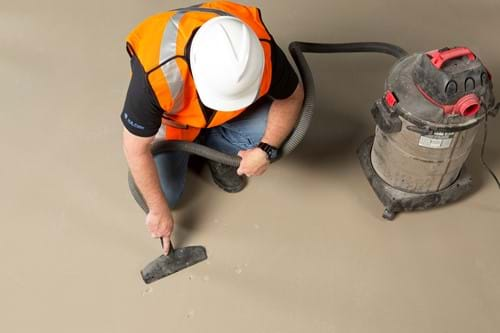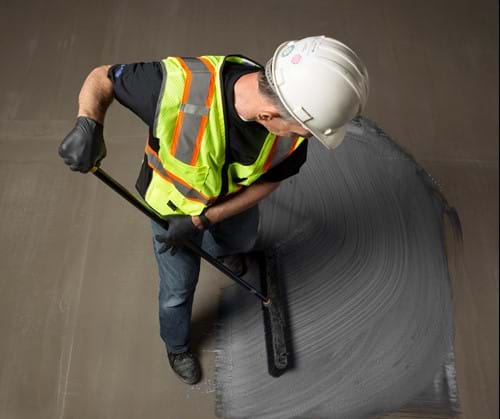Control Surface Prep Variables for Greater Profitability
Surface preparation is one the most important variables in floor construction profitability. To help control this variable and increase margins, TEC® has compiled the following best practices.
Plan ahead and communicate
Don’t skip essential due diligence and planning. Before getting to work, share your findings with the project owner and show them the value of well-planned surface prep. Stress that even though proper preparation might increase the initial cost, it will yield a higher-quality, longer-lasting floor.
Communicate the importance of proper surface prep in two ways. First, if it is a commercial project, a flooring installation failure could force temporary closure of their business, not to mention additional repair costs. If it is a residential project, they might have to pay for an entire new floor. Second, photos are powerful. Show the owner photos of failed flooring installations to emphasize the consequences of improper surface prep.
Firsthand inspection and documentation are essential
Due diligence involves a firsthand inspection of the subfloor and documentation of any potentially problematic conditions. The amount of necessary floor preparation will depend on how flat and/or level the entire floor is.
Conduct a pre-walk inspection of both the subfloor and the overall structure. Bumps can be dangerous, especially in healthcare facilities. Look for holes or voids in the subfloor through which newly placed material might leak from above. Check the surface for any surface contamination by scraping the surface with a knife blade. A fine powder indicates laitance. Use a hammer or other heavy object to detect weak or hollow areas in the subfloor and note these areas. Sprinkle water onto the surface. If the water forms droplets without absorbing immediately, the surface is non-porous and may have contaminants that need to be removed. Shotblasing is an effective way to mechanically remove contaminants from the surface of concrete.
Avoid bidding the project before you have documented any potential problems and included them in the estimate. A typical estimate should include subfloor cleaning. This includes grinding, scraping, shotblasting or other methods to remove surface contaminations. Sweeping or vacuuming up dust or other contaminants may also be required. Include a clause for cost adjustments for subfloor conditions.
Thoroughly clean subfloor for underlayment
Once the estimate has been approved, determine how much surface prep will be necessary, given the new floor’s service requirements and its environment. The subfloor must be properly cleaned, level, dry and structurally sound.
Proper surface prep ensures that the subfloor, underlayment and flooring material perform as a well-integrated system. Flooring materials such as floating carpet tile and homogeneous sheet vinyl require vastly different surface prep. Follow manufacturers’ recommendations.
Facilities such as hospitals or laboratories likely need more surface prep than retail facilities, for example, to meet floor flatness tolerances. Consider the type of facility and type of flooring material to be installed, it’s strength and flatness requirements, smoothness and point loads on the new floor.
Note that old cutback adhesive may contain asbestos, so mechanical removal of this material by sanding, grinding or blasting can be hazardous. If you find gypsum plaster or joint compound, scrub the subfloor with warm water and detergent, completely rinse off any residue and allow the concrete to dry.
For weak or damaged concrete, shotblasting or other mechanical means are required. Laitance will prevent a bond with the underlayment in these areas. You’ll also need to use a mechanical removal method such as sandblasting or shotblasting for paint that is not easily scraped off. Use these methods instead of chemical strippers on subfloors coated with paint.
Always remove surface dirt and dust using an industrial vacuum. Sweeping creates airborne silica which can cause silicosis. Avoid sweeping if possible.

Moisture control is paramount
Moisture control is necessary to ensure the long-term structural integrity of the floor. Use a properly calibrated moisture meter and follow the instructions to obtain accurate readings.
Commonly known as the in situ test, ASTM F2170 measures relative humidity (RH) within concrete slabs. Although this test has a higher initial cost, it is faster and considered more accurate than ASTM F1869, commonly known as the Calcium Chloride Test. As a result, ASTM F2170 appears to be emerging as the industry standard. The latter test provides results according to the moisture vapor emission rate (MVER). TEC® products list readings in both MVER and RH.
If necessary, you’ll want to prove that you have taken the proper steps to control moisture in the new floor. Photograph jobsite conditions and record your moisture testing results.
Self leveling underlayments need special attention
Self leveling underlayments require a few additional surface prep considerations. One is ensuring that moisture mitigation, if needed, takes place prior to installation. Check with the floor covering, self-leveling, or adhesive manufacturer to determine if moisture mitigation is necessary.
Most self leveling underlayments require that the subfloor is free of bond-inhibiting contaminants such as oil, grease, dust, paint, etc.
Remember to plug all floor openings, gaps and cracks and install termination dams to prevent material seepage. To prevent the transference of cracks in the finish, evaluate and isolate areas around walls, columns, penetrations and other building structures subject to movement to protect the adjacent flooring system.
Self leveling underlayments require the use of a primer such as TEC® Multipurpose Primer prior to installation. Primer retains the moisture within the self leveling underlayment itself to facilitate proper curing. Primer also bonds the self-leveling underlayment to the subfloor properly. Use the primer the manufacturer recommends— not doing so may result in installation failure.

Most self leveling underlayment manufacturers recommend you determine the substrate porosity for purposes of choosing the appropriate primer. You can do this with the ASTM F3191 water droplet test. If the substrate is porous, TEC recommends diluting the Multipurpose Primer. If the substrate is non-porous, TEC recommends using the Multipurpose Primer at full strength. Please check the product data sheet or call tech support at 1-800-TEC-9023.
Don’t ignore the importance of this key step
Surface prep can make or break a project. Follow these recommendations so every one of your projects lands in the ‘make’ category.
If you have any questions about which TEC® surface preparations are best for your project, please contact our Technical Support Team.
